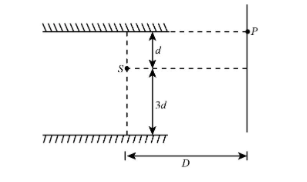
Consider the optical system shown in the figure that follows. The point source of light S is having wavelength equal to $\lambda $. The light is reaching the screen only after reflection. For point P to be 2nd maxima the value of $\lambda $ would be ($D \gg d$ $d > \lambda $):

A $\dfrac{{12{d^2}}}{D}$
B $\dfrac{{6{d^2}}}{D}$
C $\dfrac{{3{d^2}}}{D}$
D $\dfrac{{24{d^2}}}{D}$

Answer
562.5k+ views
Hint:The above problem is based on the interference of the light. The value of wavelength of the light for the second maxima on the screen can be found by using the path difference of the light for both ends of the mirror. The light from the source S can reach to point P either passing from the upper end of the mirror or lower end of the mirror.
Complete step by step answer:
Given: The wavelength of the light is $\lambda $, the distance of the light source from upper end of the mirror is d, the distance of the light source from lower end of the mirror is 3d, distance of the light source S from the screen D, the number of maxima is n = 2.

The length of the path STP is given as:
${\text{STP}} = \sqrt {{d^2} + {{\left( {\dfrac{D}{2}} \right)}^2}} + \dfrac{D}{2}$
The length of the path SUP is given as:
${\text{SUV}} = \sqrt {{{\left( {3d} \right)}^2} + {{\left( {\dfrac{D}{2}} \right)}^2}} + \sqrt {{{\left( {\dfrac{D}{2}} \right)}^2} + {{\left( {4d} \right)}^2}} $
The path difference for the light source is given as:
${\text{SUV}} - {\text{STP}} = \sqrt {{{\left( {3d} \right)}^2} + {{\left( {\dfrac{D}{2}} \right)}^2}} + \sqrt {{{\left( {\dfrac{D}{2}} \right)}^2} + {{\left( {4d} \right)}^2}} - \sqrt {{d^2} + {{\left( {\dfrac{D}{2}} \right)}^2}} + \dfrac{D}{2}$
The condition for the second maxima is given as:
${\text{SUV}} - {\text{STP}} = n\lambda $
Substitute the value of path difference and order of maxima in the above expression.
$\sqrt {{{\left( {3d} \right)}^2} + {{\left( {\dfrac{D}{2}} \right)}^2}} + \sqrt {{{\left( {\dfrac{D}{2}} \right)}^2} + {{\left( {4d} \right)}^2}} - \sqrt {{d^2} + {{\left( {\dfrac{D}{2}} \right)}^2}} + \dfrac{D}{2} = 2\lambda $
Simplifying the above expression by using the binomial expression.
$2\lambda = \dfrac{{24{d^2}}}{D}$
$\lambda = \dfrac{{12{d^2}}}{D}$
Therefore, the value of the wavelength is $\dfrac{{12{d^2}}}{D}$and the option (A) is the correct answer.
Note:Use the pythagorean theorem to calculate the path of the length from both sides of the light source. The general condition of the maxima in interference path difference = $n\lambda $ to find the value of the wavelength of the light source.
Complete step by step answer:
Given: The wavelength of the light is $\lambda $, the distance of the light source from upper end of the mirror is d, the distance of the light source from lower end of the mirror is 3d, distance of the light source S from the screen D, the number of maxima is n = 2.

The length of the path STP is given as:
${\text{STP}} = \sqrt {{d^2} + {{\left( {\dfrac{D}{2}} \right)}^2}} + \dfrac{D}{2}$
The length of the path SUP is given as:
${\text{SUV}} = \sqrt {{{\left( {3d} \right)}^2} + {{\left( {\dfrac{D}{2}} \right)}^2}} + \sqrt {{{\left( {\dfrac{D}{2}} \right)}^2} + {{\left( {4d} \right)}^2}} $
The path difference for the light source is given as:
${\text{SUV}} - {\text{STP}} = \sqrt {{{\left( {3d} \right)}^2} + {{\left( {\dfrac{D}{2}} \right)}^2}} + \sqrt {{{\left( {\dfrac{D}{2}} \right)}^2} + {{\left( {4d} \right)}^2}} - \sqrt {{d^2} + {{\left( {\dfrac{D}{2}} \right)}^2}} + \dfrac{D}{2}$
The condition for the second maxima is given as:
${\text{SUV}} - {\text{STP}} = n\lambda $
Substitute the value of path difference and order of maxima in the above expression.
$\sqrt {{{\left( {3d} \right)}^2} + {{\left( {\dfrac{D}{2}} \right)}^2}} + \sqrt {{{\left( {\dfrac{D}{2}} \right)}^2} + {{\left( {4d} \right)}^2}} - \sqrt {{d^2} + {{\left( {\dfrac{D}{2}} \right)}^2}} + \dfrac{D}{2} = 2\lambda $
Simplifying the above expression by using the binomial expression.
$2\lambda = \dfrac{{24{d^2}}}{D}$
$\lambda = \dfrac{{12{d^2}}}{D}$
Therefore, the value of the wavelength is $\dfrac{{12{d^2}}}{D}$and the option (A) is the correct answer.
Note:Use the pythagorean theorem to calculate the path of the length from both sides of the light source. The general condition of the maxima in interference path difference = $n\lambda $ to find the value of the wavelength of the light source.
Recently Updated Pages
A man running at a speed 5 ms is viewed in the side class 12 physics CBSE

The number of solutions in x in 02pi for which sqrt class 12 maths CBSE

State and explain Hardy Weinbergs Principle class 12 biology CBSE

Write any two methods of preparation of phenol Give class 12 chemistry CBSE

Which of the following statements is wrong a Amnion class 12 biology CBSE

Differentiate between action potential and resting class 12 biology CBSE

Trending doubts
What are the major means of transport Explain each class 12 social science CBSE

Which are the Top 10 Largest Countries of the World?

Draw a labelled sketch of the human eye class 12 physics CBSE

How much time does it take to bleed after eating p class 12 biology CBSE

Explain sex determination in humans with line diag class 12 biology CBSE

When was the first election held in India a 194748 class 12 sst CBSE




